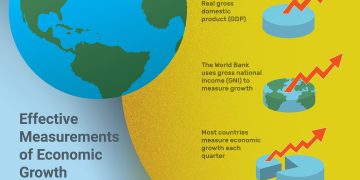Introduction
U.S. economic data plays a pivotal role in shaping Wall Street’s investment strategies. Financial markets, especially equity markets, are highly sensitive to economic indicators such as GDP growth, unemployment rates, inflation, consumer spending, and central bank policies. Investors on Wall Street, whether institutional or retail, closely monitor these data releases to adjust their investment decisions. The latest economic reports not only inform market participants about the current state of the economy but also provide critical insights into future trends and risks.
In recent months, several key economic data points have been released that have significantly influenced investment decisions on Wall Street. With ongoing challenges such as inflationary pressures, interest rate hikes by the Federal Reserve, and global geopolitical risks, understanding how the latest U.S. economic data impacts market sentiment and investment strategies is crucial for both seasoned and emerging investors.
This article explores how the most recent U.S. economic data—such as inflation figures, GDP growth, labor market statistics, and consumer sentiment—affect Wall Street’s investment strategies and decisions.
Section 1: The Role of Economic Data in Shaping Investment Strategies
1.1 Key U.S. Economic Indicators and Their Impact on Wall Street
- Inflation Data (CPI and PPI)
One of the most crucial data points for Wall Street investors is inflation data, including the Consumer Price Index (CPI) and Producer Price Index (PPI). Inflation readings provide insight into price pressures in the economy, influencing central bank policies, especially those of the Federal Reserve.- Effect on Fed’s Monetary Policy: When inflation rises above the Fed’s target of 2%, it typically prompts the central bank to tighten monetary policy by raising interest rates. Rising interest rates can have a direct impact on stock prices, especially those of growth companies, which rely on low borrowing costs to fuel expansion. The latest CPI or PPI data, showing persistent inflation, encourages Wall Street to brace for continued rate hikes, which in turn affects sector performance and market sentiment.
- Sector Impact: In response to inflationary pressures, Wall Street may favor sectors that tend to perform well during periods of rising inflation, such as energy, materials, and consumer staples. Conversely, sectors such as technology, real estate, and growth stocks may experience declines due to higher discount rates affecting their valuations.
- Gross Domestic Product (GDP) Growth
GDP growth is another significant economic indicator that can shape Wall Street’s investment strategies. GDP growth reflects the overall health of the economy and is closely watched by investors for signs of strength or weakness.- Impact on Risk Appetite: Strong GDP growth typically signals a healthy economy and boosts investor confidence. In such conditions, Wall Street investors are more likely to take on riskier investments, favoring equities, particularly in cyclical sectors like consumer discretionary, industrials, and technology. On the other hand, weak or negative GDP growth often signals an economic slowdown or recession, leading to a more cautious approach on Wall Street.
- Recession Fears: In recent months, several quarterly GDP reports have shown signs of slowing economic growth, causing concern among investors about the potential for a recession. If GDP growth fails to meet expectations, it can prompt a flight to safer assets like bonds, gold, and dividend-paying stocks, with Wall Street investors reassessing their risk exposure.
- Unemployment and Labor Market Data
The labor market data, particularly the monthly jobs report from the U.S. Bureau of Labor Statistics, is a key indicator that shapes investment strategies. The unemployment rate, non-farm payrolls (NFP), and labor force participation rate provide critical insights into the strength of the labor market and consumer sentiment.- Strong Job Growth: If job growth is strong, it often signals a robust economy, which can positively affect consumer spending. Wall Street generally views this as a sign of economic resilience, leading to bullish sentiment and a favorable outlook for stocks in consumer-related sectors.
- Job Losses or High Unemployment: Conversely, a rise in unemployment or weaker-than-expected job creation can signal economic distress and reduced consumer confidence. In such cases, Wall Street investors may reassess their portfolios and shift focus to more defensive sectors like healthcare, utilities, and consumer staples, which tend to outperform during economic slowdowns.
- Wage Growth and Inflation: Additionally, strong wage growth, which often accompanies low unemployment, can contribute to inflationary pressures. Wall Street closely watches wage growth data because it has implications for inflation, central bank policy, and consumer spending power.
- Consumer Sentiment and Spending
Consumer sentiment, as measured by indices like the University of Michigan Consumer Sentiment Index and retail sales data, provides an early warning of shifts in consumer behavior. As consumer spending accounts for a significant portion of GDP, changes in consumer confidence can have an outsized impact on financial markets.- Strong Consumer Spending: When consumer sentiment is high, and retail sales are strong, it often indicates that consumers are confident in their financial situation. Wall Street tends to favor sectors reliant on consumer spending, such as retail, entertainment, and technology.
- Weakening Consumer Sentiment: If consumer confidence declines, perhaps due to rising costs of living or economic uncertainty, it can signal reduced spending and a slowdown in economic activity. Wall Street may respond by reducing exposure to consumer discretionary stocks, while emphasizing more resilient sectors, such as utilities or healthcare.
1.2 Wall Street’s Reaction to Economic Data Releases
Wall Street investors rely on economic data releases to adjust their portfolios and identify trends. The immediate impact of economic data on stock prices is often evident through:
- Market Volatility: Economic data releases can lead to immediate market movements. For example, a higher-than-expected inflation report may cause a sell-off in growth stocks as investors react to the prospect of tighter monetary policy. Similarly, better-than-expected GDP growth or jobs data might boost investor optimism, leading to a rally in cyclical stocks.
- Sector Rotation: As economic data influences investor sentiment, sector rotation becomes a common strategy. If inflation is high and the Federal Reserve is expected to hike rates, Wall Street may shift investments from growth sectors like technology to defensive sectors such as consumer staples, healthcare, and utilities.
- Long-Term Strategic Shifts: Economic data doesn’t just drive short-term trading; it can lead to longer-term shifts in Wall Street’s broader investment strategy. For example, if inflation remains persistent, it might prompt investors to focus on inflation-hedging assets, such as commodities (especially gold) or inflation-linked bonds.

Section 2: The Federal Reserve and Its Influence on Wall Street
2.1 Fed’s Actions in Response to Economic Data
The Federal Reserve’s policy decisions are heavily influenced by the economic data that is released. Central bank actions on interest rates, quantitative easing, and inflation targeting can have a profound effect on Wall Street’s investment strategies.
- Interest Rate Hikes: If inflation remains high, the Federal Reserve may choose to raise interest rates in an effort to curb rising prices. Higher interest rates can hurt stock prices, especially in sectors that are sensitive to borrowing costs, such as technology. The Fed’s stance on interest rates can lead to either optimism (if rates remain low) or caution (if rate hikes are expected) in the markets.
- Quantitative Tightening: As part of its effort to manage inflation, the Fed may also engage in quantitative tightening (QT), which involves reducing its balance sheet by selling assets. This action reduces the liquidity in the financial system, which could have a significant impact on asset prices across equities, bonds, and real estate.
2.2 Forward Guidance and Market Expectations
In addition to actual economic data, Wall Street is keenly focused on the Fed’s forward guidance. Central bank communication provides insights into the future trajectory of interest rates, the economic outlook, and its assessment of inflationary pressures.
- Guidance on Future Rate Hikes: The Fed’s statements about future interest rate hikes are carefully watched by investors. If the Fed signals that it intends to keep rates high for a prolonged period to control inflation, it can dampen risk appetite on Wall Street. On the other hand, a more dovish stance, signaling the potential for rate cuts, might prompt investors to favor more growth-oriented investments.
- Market Expectations vs. Reality: Wall Street’s reaction to Fed announcements often hinges on the alignment between market expectations and the actual policy stance. If the Fed surprises the market with more aggressive rate hikes than expected, it could lead to a sharp pullback in equity markets.
Section 3: Conclusion
The latest U.S. economic data plays a central role in shaping Wall Street’s investment strategies. Inflation data, GDP growth, unemployment figures, and consumer sentiment all influence investor decisions by providing insights into the overall economic environment. These indicators not only affect short-term market volatility but also guide long-term strategic shifts across different sectors.
Given the persistent concerns around inflation, interest rates, and potential economic slowdown, Wall Street investors must remain agile and responsive to these data releases. Whether it involves shifting to more defensive stocks, embracing sector rotation, or adjusting to changing Fed policies, understanding the impact of the latest economic data is key to navigating an uncertain market environment.
By staying informed and adjusting their investment strategies according to the evolving economic landscape, investors can better position themselves for potential opportunities and risks in the months ahead.



































